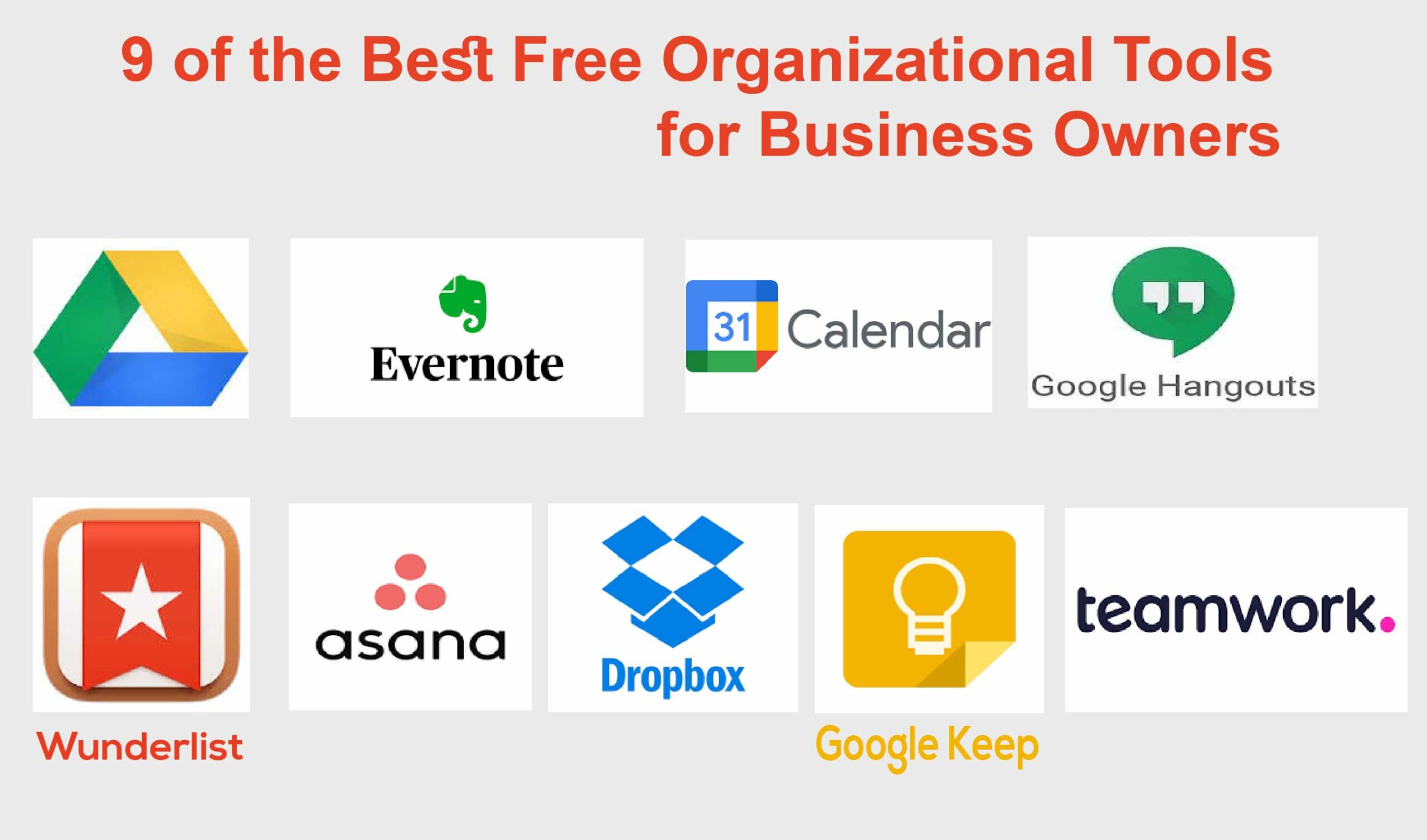Organizing a business is crucial to its success. Without it, things can quickly spiral out of control. You can only keep track of some things when you constantly get requests, invitations, and event updates.
In this case, some free organizational tools for work help keep you organized. A few popular options are Google Drive, Google Calendar, and Evernote, which offer various features to keep your business organized and running smoothly.
We will also share other best organizational tools for business owners. This guide includes tips on time management, productivity, and goal setting. Also, we’ve included our favorite tools for each category.
What Are the Best Free Organizational Tools for a Business?
As a business owner, you are likely always on the go and dealing with multiple tasks simultaneously. This can make remembering upcoming appointments, meetings, and other events difficult.
There are several small business organization tools that can keep their companies running smoothly. Here we will discuss 10 of the best.
1. Google Drive:
A great cloud-based storage solution that’s free for up to 15GB of data. It offers a variety of integrations that make it flexible and easy to use. Using Drive for desktop, you can access files right from your computer. Sync files faster and spends more time working.
Business owners can use it to create and store Google docs, spreadsheets, presentations, and more. They can also use it to share files with other people, collaborate on projects, and track tasks. It keeps your files private until you don’t share them.
2. Evernote
While there are myriad ways to organize your business, Evernote one of the best free printable organizational tools that can be extremely helpful is Evernote. It is a versatile note-taking tool that’s free to upload up to 60MB of monthly data. Small business owners benefit from it including:
Available on All Major Platforms:
It’s available in all major operating systems, including iOS, Android, and Windows. So, you can download the Evernote app and use it on your desktop, smartphone, or laptop. With Evernote, you can capture information in notes and synchronize them across all of your devices.
Separate Content with Individual Notebooks:
This handy tool makes grouping content in individual notebooks easy. You can create a notebook for payroll information, another for licenses, and another for marketing ideas. It lets you tag each note so you can easily find it later.
Tag Notes and To-Dos:
You can create and tag to-do lists to find them later easily. If you have a meeting with a client, you can tag the meeting notes as “client meeting.”
Integrates with Other Tools:
Evernote integrates with other online tools, such as Google Drive and Dropbox. So, you can use it alongside other productivity tools.
Scan and Save Images:
With it, you can scan documents, save images, and photograph business cards, receipts, and bills. This allows you to declutter your workspace and focus on what matters.
Remind Your Important Deadlines:
Evernote can remind you of important deadlines and help you free up more of your brain by organizing your thoughts and ideas. This way, it helps business owners organize their businesses and stay on track.
Search Your Notes:
It simplifies the search process so you can find what you’re looking for quickly and easily. For example, you can search for a specific note by title or date last modified.
Access Your Notes Offline:
You can access your notes offline if your mobile internet connection is interrupted. It is handy if you’re on a plane or in an area with limited or no internet connectivity.
Set Up Passwords:
To secure your notes, you can set up a password for an entire notebook or individual notes. When you set a password for a notebook, every note in that notebook is secured.
Template Gallery:
Its gallery has many templates that can help streamline your business. For example, you can use a template to create a business plan or track your progress on a project.
A template can also assist you in managing your finances or developing a marketing strategy. With so many options available, you are always ahead of step 1 regarding organization and efficiency.
3. Google Calendar:
Google Calendar is used for various purposes to organize a business. With its easy-to-use interface and powerful features, it is one of the most popular calendar applications today. Here is a list of things you can do with it:
Planning and Scheduling Team Meetings:
You can rely on it to create and manage team meetings. The system allows you to add rooms, create recurring events, and attach documents. You can also use color to help you quickly identify different events. And once you’ve created an event, save it so that you can easily access it later.
Update Business Events:
With the calendar, you can quickly and easily view upcoming meetings, reply to invitations, and check guest attendance. You can reply to and update events. Canceling or rescheduling an event is as simple as clicking a few buttons. If you accidentally delete an event, restoring it is easy.
Add Corporate Meeting Locations:
Add the location of your corporate events or meetings using Google Maps integration. Your guest or employee can get directions to get there. So, keep your mind at peace so your appointment won’t get lost in the crowd.
Create Task with Project:
The business owner creates a task and then selects the project to which it belongs. They assign the task to an employee by simply clicking on their name. Also, they set a due date for the task and click “Save.”
It is extremely efficient and helps to ensure that all tasks are properly accounted for and assigned. Google Calendar allows business owners to view, edit, and delete tasks as needed. This flexibility ensures that business owners have complete control over their schedules.
Create Reminders for a Project:
With the online tool, you can create project reminders and view them on your phone or computer. Edit them as needed and mark them as done when you’re finished. You can also delete reminders that are no longer needed.
Sharing Information with Coworkers:
Anyone who has tried to coordinate a meeting or project knows how challenging it can be to get everyone on the same page. This is especially true for business owners, who often have to juggle multiple calendars and schedules.
With Google Calendar, users can share information with coworkers or clients, view other people’s calendars, and create shared calendars. This can be a valuable way to track projects, deadlines, and meetings. It also offers features like reminders and notifications to stay on top of their busy schedules.
Available Several Integrations:
By integrating with productivity apps like Gmail, G-drive, Contacts, Hangouts, and Trello, users can be more productive. And because Calendar naturally integrates with Google Workspace apps, there’s no need to waste time on planning or scheduling between different platforms.
It gives them visibility into what everyone on their team is working on. You can access your calendar from multiple devices, including your computer, phone, and tablet.
4. Wunderlist
Another great simple to-do list app is Wunderlist. It has many features you’d expect in a to-do list app, such as:
Multi-platform Support:
Wunderlist works on all major platforms, including Windows, Mac, Linux, Android, and iOS. So, you can use it without sitting in front of your computer.
Create Multiple Lists:
It is great to keep track of different tasks for different projects. You can create different folders for different areas of your business, such as Marketing, HR, or Customer Service.
Share Your Work Lists with Teammates:
If you’re looking for a simple, effective way to share work lists with teammates, you can try it. You can invite them via email or share a link. It’s great for adding details or attaching files. This is great for team collaboration.
Track of Your Progress:
Wunderlist lets you keep track of everything and see who is working on what. To get started, create a new list and invite your teammates to join. Add tasks and assign them to team members.
Set Dates and Reminders:
You can set time limits and reminders to help keep everyone on track. Once your list is complete, sharing it with your team via email or chat is possible. And if you need to make any changes, you can easily edit the list from within Wunderlist.
Integrates with Other Services:
Wunderlist integrates with several other services, including Evernote, Dropbox, OneNote, and Google Drive. Adding your to-do items from other apps and services makes it easy.
5. Asana
Asana is a productivity tool that helps teams track their work and get results. It has various features that make it a powerful project management tool.
Free for up to 15 teammates:
It enables teams of up to 15 people at no cost. With Asana, your team can collaborate and track projects together in one place while accessing analytics on their performance throughout the project cycle.
Unlimited Tasks and Projects:
Asana allows you to create an unlimited number of tasks, making it easier to track all the work that needs to be done. These tasks can be split into smaller units so that each team member can focus on a specific task.
You can also add deadlines and subtasks to each task, making managing your tasks and projects easier. This is ideal for companies with a large number of employees or teams working on multiple projects at the same time.
Different Project Templates:
Asana provides templates for different projects, making it easy to start a new project. These templates can be customized to fit the specific needs of your team. It makes it easy to start with Asana and ensures that all team members use the same project management tool.
Integrations:
This powerful tool offers 100 free integrations with other apps and services. You can easily connect Asana to Dropbox, Google Drive, and other online tools you already use.
Mobile Apps:
Asana also has iOS and Android apps so you can manage your work from anywhere. These apps sync with the Asana web app so you can stay up to date on your work no matter where you are.
6. Dropbox:
For a business, file storing and sharing are crucial. It helps the business to manage its data and files efficiently. Dropbox is one such file-sharing tool that has been designed for businesses of all sizes. Let’s see the features of Dropbox that make it an ideal choice for businesses-
File Storage:
It offers 2 GB of free storage to store all your important files in one place. You can also organize your files into different folders, making it easy to find what you need. It allows you to save large files, so you don’t have to worry about running out of space.
File Sharing:
You can share files with anyone, even if they don’t have a Dropbox account. All you need is the link to the file. You can also set permissions, so only certain people can access or edit the file.
Sync Files:
All your devices can sync your files, so you always have the most up-to-date version. You can access your Dropbox account from any device to work on your files anytime, anywhere. When working on a mobile device, you can even store files offline.
Integrations:
Dropbox integrates with several other apps and services, making it easy to use with the tools you already use. The service includes Zapier, Asana, Salesforce, Zoho CRM, and more.
7. Teamwork:
Many apps out there promise to make business organization easier, but only some deliver on that promise, like Teamwork. It is an all-in-one platform that allows businesses to manage projects, clients, and team members in one place. Here are reasons to use this app:
Assign Tasks to Teammates:
You can create projects, assign tasks to team members, and set due dates and priorities. It ensures that everyone knows what their responsibilities are.
Communicate with Co-workers:
The tool makes communicating with team members and co-workers easy. You can send messages and have discussions within the app, making it great for coordinating workflows.
Generate Reports:
It also allows businesses to generate reports, so you can track progress and identify areas that need improvement. You can create expense reports, invoices, and time-tracking reports. This information can be beneficial in making sure that your business is running smoothly.
Access from Anywhere:
As it is a cloud-based service, you can access it from anywhere. But what really sets Teamwork apart is its ease of use. Its interface is clean and intuitive, and users can get up and running in minutes.
8. Google Hangout
The Google Hangout app is a versatile tool that can be used for a variety of purposes, including organizing a business. The app offers a number of features that make it well-suited for this task, such as:
Create Task for Employee:
You can create a task for an employee and assign it to them. This is a great way to track what needs to be done and ensure that it gets done on time. With it, you can add a time frame for the task and set reminders, so the employee knows when it’s due.
It can be used to store and share files such as PDFs, images, presentations, and spreadsheets. In addition, you can use a doc file to write and share a blog post.
Video Calling and Screen Sharing:
The app also offers video calling to meet with team members or clients. You can share your screen with others through the app, which is great for presentations or training sessions. This way, everyone can see what you’re working on and follow along.
Group Chat:
It allows you to create group chats to coordinate with colleagues easily. So, you don’t need to send messages individually to every team member. But the only owner of the group can add members on Google Hangout.
Integrates with Google Apps:
The app also integrates with other Google apps, such as Gmail, Drive, Calendar, contact, and Google keep. It makes it easy to keep all your business information in one place, saving you time and money.
9. Google Keep:
Google Keep is a great app for small businesses because it allows you to keep track of all your important information in one place. It’s easy to use and offers many features such as:
Note-taking:
Google Keep is a handy app that helps you organize your business by allowing you to create, edit, and save notes on your computer, phone, or tablet. Even if there’s no connection, you can still edit your notes.
When there is an internet connection, they save automatically. The app updates all devices, so you’ll never have to worry about losing important information. From photos, you can capture image notes. You can share notes with others, which is helpful for team collaboration.
Find Information Faster:
Its search function lets you quickly find the information you need. You can pin important notes to the top of your list so that you never forget them.
The filter options help you narrow down your results. You can also filter by attributes, such as lists with audio notes, images, and labels. This makes it easy to find the notes you need.
Reminders:
With Google Keep, you can create alerts reminding you of deadlines, upcoming meetings, and any other important tasks. You can also set reminders based on location, so you’ll never miss an appointment or an important phone call.
And because Google Keep is available on both your mobile device and your computer, you can access your lists and reminders from anywhere. So, whether you’re at your desk or on the go, you can always stay organized and on top of your business.
How to Choose the Right Organization Tools for You?
Nowadays, endless organization tools are available to help us manage our lives. From digital task managers to physical planners and bullet journals, the options can seem overwhelming. So, here are tips for picking the right organization tools:
Personal Preferences:
Do you like things to be neat and tidy, or do you prefer a more relaxed approach? Would you prefer everything to have its own place, or would you be okay with a little overlap? Once you’ve decided on a general style, you can start looking at specific products.
Analog or Digital Way:
The software might be the way to go if you find that you work better online. You can have different software for different tasks, and during the day, you can switch between them as needed. This streamlines your process and helps you stay focused.
On the other hand, if you prefer to work offline, analog is better. You can use a planner to keep track of your tasks and use a notebook for brainstorming and taking notes.
How Much Stuff Do You Need to Organize?
If you only have a few items, a simple storage solution might suffice. But if you have a lot of stuff or need to access your things frequently, something more robust might be necessary.
Free or Paid:
Organization tools are available at a wide range of price points. Paid tools need a one-time subscription, which helps you keep your data more secure. Sometimes you have a monthly or yearly subscription for the organization tools.
You can find plenty of free options, though they may not be as feature-rich as the paid ones. If you’re on a tight budget, free options are definitely worth considering.
What Tools Suit Your Job?
The type of organization tools you need depends on your job. You might need a tool with lots of functions for managing projects and tasks if you work in an office. When working at home remotely, you might need a light tool to help you stay on top of deadlines.
If you’re a student, keep track of assignments and due dates with a tool. And if you’re a busy parent, a scheduling tool might help you. No matter your job, there’s an organization tool out there that can help you be more productive.
Five Tips on How to Organize a Small Business?
A well-organized workspace is crucial for any small business. Not only does it help to create a professional appearance, but it also makes it easier to find important documents and supplies. Here are some suggestions to help you keep your workspace organized:
1. Maintain a Clutter-free Workspace:
Cluttered desks are a sign of cluttered minds. When your workspace is messy, it can be harder to focus and be productive. Spend a few minutes each day decluttering your desk, and you’ll see a difference in your productivity.
2. Stay Organized Online:
In today’s world, much of our work is done online. This can make it easy to lose track of important files and documents.
To stay organized, create a system for storing and labeling your online files. It will help you find what you need quickly and avoid wasting time searching through a cluttered inbox. You can use an online tool like Google Drive or Dropbox to store your files in the cloud.
3. Get Organized with Task Lists:
One of the best ways to manage your work is to create task lists. Write down everything you need to do, then cross items off as you complete them.
If you have employees or assistants, assign them specific tasks and responsibilities to help with the overall organization of the workplace. Trello or Asana are good options for this.
4. Use a Calendar:
A calendar is an essential tool for any small business owner. Use it to track deadlines, appointments, and other important dates. It will help you plan ahead and avoid missing any important commitments. The best way to use google calendar is to synchronize it with your email and online task lists.
5. Create Templates:
If you do the same tasks repeatedly, save time by creating templates. This could be a template for invoices, reports, or documents you frequently need to create. Having a template will help you get the job done quickly and efficiently.
Does Google Have a Task Management Tool?
Yes, Google Tasks is a great task management tool for small businesses. It allows users to create lists, add tasks, sort tasks, add notes and due dates., and share tasks with others.
You can also use keyboard shortcuts to add or edit tasks quickly. Plus, you can find and edit pending tasks in Calendar. Google Tasks will keep track of your to-do list and get things done.
Are Google Tasks Free?
Google Tasks is available for free with a Google account. It has some features that can be really helpful, such as notes, reminders, and the ability to share information with others.
You can access it from the Google app on Android and iOS devices and the Google search page on the web. Google Tasks is a powerful tool for managing personal tasks, work projects, or school assignments.
How Can You Organize Your Business with no Money?
Organizing a business can be challenging, especially if you have little money to spend. There are several free organizational tools for businesses to use. For example, Google offers a suite of productivity tools like Gmail, Drive, and Calendar that can be useful for small businesses.
You can use pencil and paper if digital tools are different from what you do. You can use a simple filing system to keep track of important papers or use a whiteboard to jot down ideas and brainstorm with colleagues. So, don’t feel you can’t get organized without spending a lot.
Versoriaonline is the best place to teach you leadership skills that you need to grow your business.





